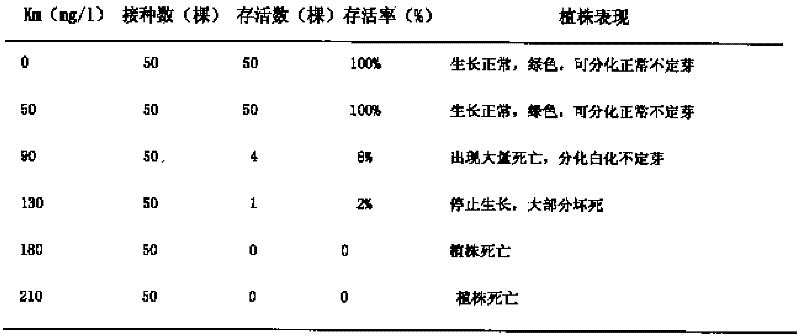Method for creating cut flower gypsophila paniculata liriomyza sativae blandchard variety by transgene
A technology of Liriomyza sativae and Gypsophila gypsophila, applied in horticultural methods, genetic engineering, plant genetic improvement, etc., can solve the problems of chemical pesticides polluting the environment, limited effectiveness, and high cost, and achieve the effect of reducing costs and reducing the degree of disease
- Summary
- Abstract
- Description
- Claims
- Application Information
AI Technical Summary
Problems solved by technology
Method used
Image
Examples
Embodiment 1
[0024] A. Establishment of the efficient transformation and regeneration system of Gypsophila gypsophila: select a single plant of Gypsophila gypsophila that grows healthy under in vitro culture conditions, take small leaves as materials under sterile conditions, and in the differentiation medium: Ms+BA 1.0mg / Cultured on L+NAA 0.3mg / L for 18 days, wherein, the culture temperature was 25°C, the light intensity was 2000lx, and small buds were differentiated from the base of Gypsophila;
[0025] B, the transformation of Bt gene to Gypsophila:
[0026] (1) Preparation of Agrobacterium Competent Cells
[0027] Agrobacterium LBA4404 was inoculated in 5ml of LB liquid medium containing 50mg / L of Km and 5mg / L of Rif, cultivated overnight at 28°C and 200rpm; Continue culturing in Rif LB liquid medium until OD600 is 0.5, put the culture in ice bath for 30min, centrifuge at 5000rpm at 4°C for 5min, discard the supernatant, and replace it with 1ml of cold CaCl with a concentration of 20...
PUM
 Login to View More
Login to View More Abstract
Description
Claims
Application Information
 Login to View More
Login to View More - R&D
- Intellectual Property
- Life Sciences
- Materials
- Tech Scout
- Unparalleled Data Quality
- Higher Quality Content
- 60% Fewer Hallucinations
Browse by: Latest US Patents, China's latest patents, Technical Efficacy Thesaurus, Application Domain, Technology Topic, Popular Technical Reports.
© 2025 PatSnap. All rights reserved.Legal|Privacy policy|Modern Slavery Act Transparency Statement|Sitemap|About US| Contact US: help@patsnap.com


